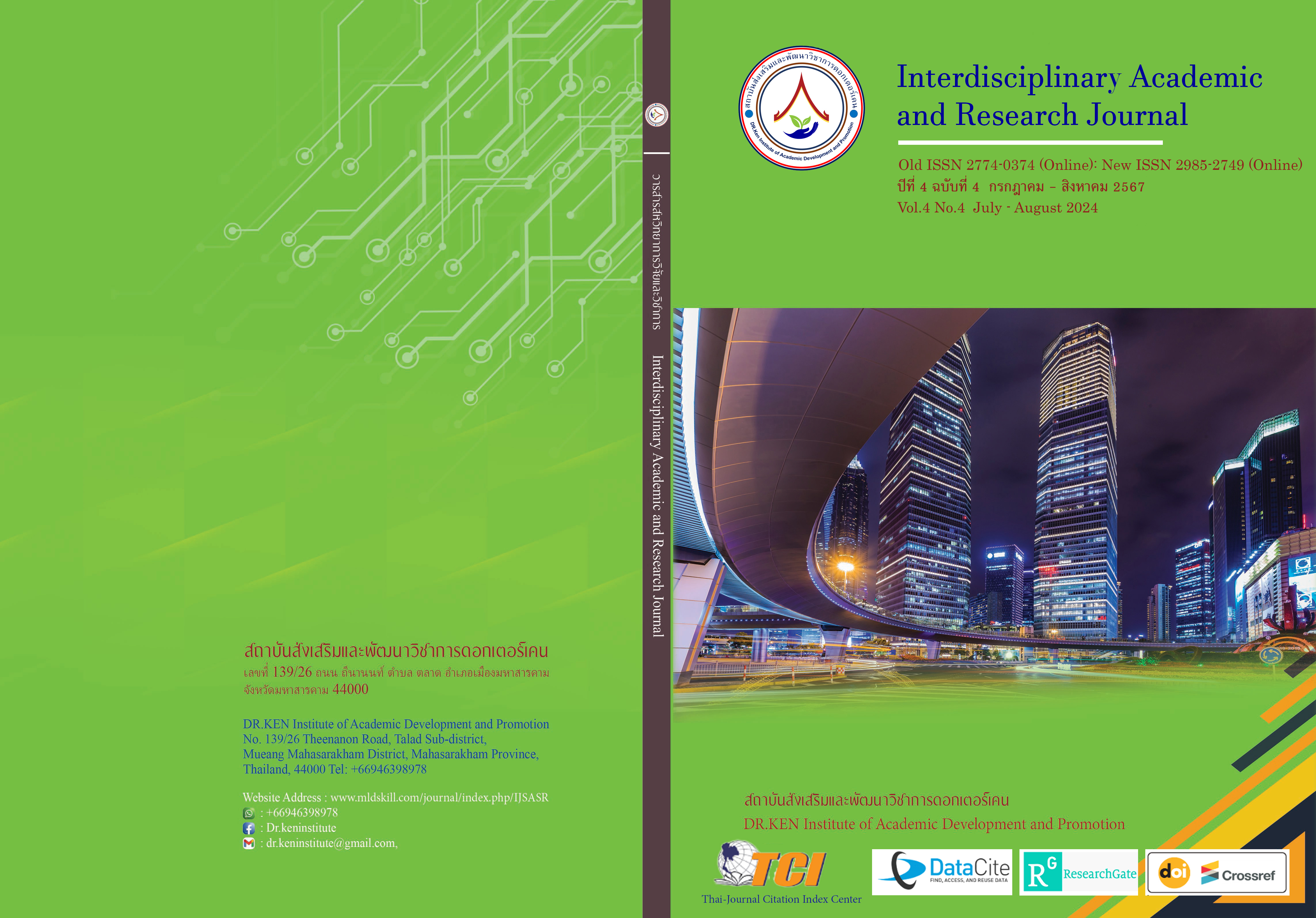Relationship Between Bench Press and Bench Row, Bence Press and Ergometer, and Bench Row and Ergometer of Thai Men Players Not Under Than 50 Years Old, Whom They Make to Thailand Rowing Players on BE. 2565
DOI:
https://doi.org/10.60027/iarj.2024.274419Keywords:
Bench Press; , Bench Row; , ErgometerAbstract
Background and Aims: The basic sports aim was to improve strength physique and sports performance. Rowing is a sport that uses endurance and muscular strength as important factors, in which team relations and rowing skills are a factor in the work of the body. The purpose of this research was to study the relationship between Bench Press and Bench Row, Bench Press and Ergometer, and Bench Row and Ergometer of Thai men players not under 50 years old who they make to Thailand rowing players on BE.2565.
Methodology: The target group was Thai men players not under 50 years old, whom they make to Thailand rowing players on BE.2565. They were 42 men, who were good at 23 right rowing person group and 19 left rowing person group. The research instrument used in this study was testing included 3 items, which were Bench Press, Bench Row, and Ergometer. The descriptive analysis was Pearson’s product-moment correlation coefficient processed through a software package computer program.
Results: (1) The correlation coefficient between Bench Press and Bench Row if they were good at the right rowing person group was .783 at a statistically significant level .01. (2) The correlation coefficient between Bench Press and Bench Row if they were good at the left rowing person group was .765 at a statistically significant level .01. (3) The correlation coefficient between Bench Press and Bench Row if they were good at the right and left rowing person group was .782 at a statistically significant level .01. (4) The correlation coefficient between the Bench Press and Ergometer of they were good at right rowing person group was -.469 at a statistically significant level .05. (5) The correlation coefficient between the Bench Press and Ergometer of they were good at left rowing person group was -.327 at a not statistically significant level of .05. (6) The correlation coefficient between the Bench Press and Ergometer of they were good at right and left rowing person group was -.420 at a statistically significant level of .01. (7) The correlation coefficient between Bench Row and Ergometer of they were good at right rowing person group was -.706 at a statistical level .01. (8) The correlation coefficient between Bench Row and Ergometer of they were good at left rowing person group was -.323 at a not statistical significant level .05. And (9) The correlation coefficient between Bench Row and Ergometer of they were good at right and left rowing person group was -.541 at a statistically significant level .01
Conclusion: The results of the correlation analysis show that the relationship between Bench Press, Bench Row, and Ergometer performance is highly impacted by rowing proficiency—either left, right, or both. Bench Press and Ergometer have a markedly negative association, especially in the right rowing group, whereas Bench Press and Bench Row show strong positive correlations in both the right and left rowing groups. Furthermore, for every proficiency group, Bench Row exhibits constant negative correlations with Ergometer performance, indicating the unique impact of rowing abilities on Ergometer performance.
References
กระทรวงการท่องเที่ยวและกีฬา. (2550). แผนพัฒนาการกีฬาแห่งชาติฉบับที่ 4 (พ.ศ. 2550-2554). กรุงเทพมหานคร: กระทรวงการท่องเที่ยวและกีฬา.
เกรียงไกร รอดปัญญา, และศาสตราวิทย์ วงศ์บุตรลีวัฒนา. (2566). ความสัมพันธ์ระหว่างเวลาการพายเรือ การลุกนั่ง การดันพื้น และอัตราชีพจรของนักกีฬาเรือพาย ประเภททีมผสม ชมรมกีฬาเรือพายอาวุโสจังหวัดสมุทรปราการ. วารสารสหวิทยาการวิจัยและวิชาการ, 3(2), 307-318.
ถนอมศักดิ์ เสนาคำ, เกริกวิทย์ พงศ์ศรี, ศิริเชษฐ์ พูลทิพายานนท์, และณพล สุวรรณทัต. (2558). การพยากรณ์สมรรถนะของการพายเรือมังกรประเภทสปริ๊นระยะ 500 เมตร ในนักกีฬาเรือพายเพศหญิง. วารสารคณะพลศึกษา, 18 (1), 69-78.
นภพร ทัศนัยนา. (2536). ปัจจัยคัดสรรที่มีผลต่อความสำเร็จมนการแข่งขันกีฬา. วิทยานิพนธ์ครุศาสตรดุษฎีบัณฑิต: สาขาวิชาพลศึกษา, บัณฑิตวิทยาลัย, จุฬาลงกรณ์มหาวิทยาลัย.
นุชบา พลกุล และคุรุศาสตร์ คนหาญ. (2562). ความสัมพันธ์ระหว่างอัตราการใช้พลังงานของรยางค์ร่างกายกับความเร็วของการพายในนักกีฬาเรือกรรเชียงชายระดับทีมชาติ. การประชุมทางวิชาการเสนอผลงานวิจัยระดับบัณฑิตศึกษาแห่งชาติ ครั้งที่ 20 วันที่ 15 มีนาคม 2562 มหาวิทยาลัยขอนแก่น.
พระราชบัญญัติการกีฬาแห่งประเทศไทย พุทธศักราช 2528. ราชกิจจานุเบกษา, เล่ม 102 ตอน 149 ฉบับพิเศษ, 17 ตุลาคม พ.ศ. 2528 หน้า 1-23.
พวงรัตน์ ทวีรัตน์. (2543). การสร้างและพัฒนาแบบทดสอบผลสัมฤทธิ์. กรุงเทพฯ: สำนักทดสอบทางการศึกษาและจิตวิทยา, มหาวิทยาลัยศรีนครินวิโรฒประสานมิตร.
ศุภามาส อังศุโชติ. (2565). เทคนิคการวิเคราะห์ความสัมพันธ์ระหว่างตัวแปร. Retrieved on December 15, 2022 from:https://www.stou.ac.th/offices/ore/info/cae/uploads/pdf/636366560441132172.pdf
เสาวนีย์ คำแสง. (2561). ผลการฝึกพลัยโอเมตริกด้วยเมดิซินบอลและการฝึกเวทเทรนนิ่งต่อความเร็วในการพายเรือมังกร. วิทยานิพนธ์ศึกษาศาสตรมหาบัณฑิต: มหาวิทยาลัยการกีฬาแห่งชาติ.
Gentil, P., Bottaro, M., Oliveira, E., & Nosaka, K. (2006). Muscle activation during bench press exercises performed with and without the preexhaustion method. Journal of Strength and Conditioning Research, 20(3), 696-699.
Kongpetch, C. (2020). Exercise for the elderly. Thai Journal of Nursing, 68(4), 64–71. Retrieved from https://he02.tci-thaijo.org/index.php/TJN/article/view/233553
Suchomel, T. J., Nimphius, S., & Stone, M. H. (2016). The importance of muscular strength: training considerations. Sports Medicine, 46(10), 1419-1449.
Downloads
Published
How to Cite
Issue
Section
License
Copyright (c) 2024 Interdisciplinary Academic and Research Journal

This work is licensed under a Creative Commons Attribution-NonCommercial-NoDerivatives 4.0 International License.
Copyright on any article in the Interdisciplinary Academic and Research Journal is retained by the author(s) under the under the Creative Commons Attribution-NonCommercial-NoDerivatives 4.0 International License. Permission to use text, content, images, etc. of publication. Any user to read, download, copy, distribute, print, search, or link to the full texts of articles, crawl them for indexing, pass them as data to software, or use them for any other lawful purpose. But do not use it for commercial use or with the intent to benefit any business.
















.png)


